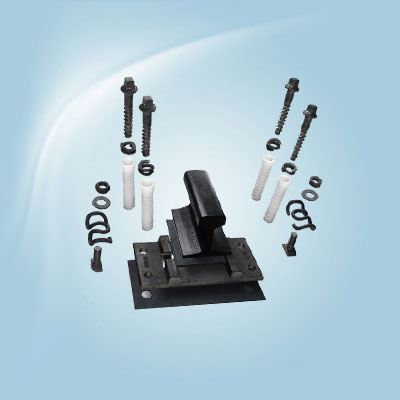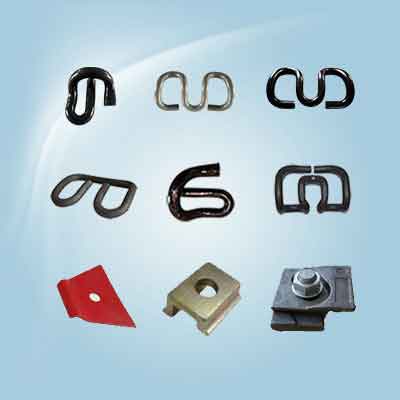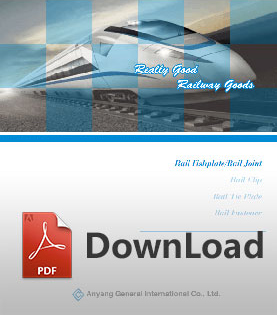How much do you know about railway sleepers?

The railway sleeper is a type of railway accessory. The railway sleeper not only supports the steel rail, but also maintains the position of the rail, and transmits the huge pressure transmitted by the rail to the track bed. It must have a certain degree of flexibility and elasticity. When the train passes, it can be properly deformed to cushion the pressure, but the train must be restored as much as possible.
The railway sleeper was originally made of wood. The elasticity and insulation of the wood is good. Wooden sleeper is less affected by the temperature change of the surrounding medium, light weight, easy to replace on the processing or on the railway line, and it also has sufficient displacement resistance. After the anti-corrosion treatment of the wooden sleeper, the service life is also greatly extended, about 15 years. Therefore, 90% of railway lines in the world use wooden sleepers. With the reduction of forest resources and the increase of people's awareness of environmental protection, of course, due to the development of science and technology, at the beginning of the last century, some countries began to produce steel railway sleepers and reinforced concrete sleepers to replace wooden sleepers. However, because the metal consumption of the steel sleeper is too large, the cost is high, the volume is cumbersome, and it has not been promoted. Only a few countries such as Germany are still using it. In many countries, reinforced concrete sleepers have been widely produced since the 1950s.
Wooden sleeper

The wooden sleeper is made of wood, also known as sleeper wood, anti-corrosion wooden sleepers, also known as oil-filled sleepers. Tough and flexible wood must be used for making wooden sleepers. Wooden sleepers can be divided into ordinary wooden sleeper, squat sleepers and bridge sleepers according to their use.
However, due to the material, the elasticity, strength and durability of the wooden sleeper are not uniform enough, which will increase the wheel-rail dynamics and consume a large amount of high-quality wood. The wooden sleeper has a short service life and has many causes of failure, mainly include decay, mechanical wear and cracking. Because the wooden sleeper is easy to decay, in order to effectively extend the service life, the sleeper must generally be used after oiling and anti-corrosion. The wooden sleeper without preservative treatment is called a plain pillow. China's timber resources are relatively scarce and expensive, and have been gradually replaced by concrete sleepers on major railway lines.
Advantages of wooden sleepers- Good elasticity (not easy to break), light weight, simple production, good insulation performance, low price, simple connection between rail fastening system and wooden sleepers, convenient for laying, processing and transportation;
- There is a large coefficient of friction between the wooden sleeper and the gravel ballast;
- The sleeper has good plasticity and can be processed according to the actual situation, with less waste.
At present, China's standard railway gauge is 1435mm. The standard wooden sleeper specifications are as follows:
- Ordinary sleepers: width 220mm; thickness 160mm; length 2500mm;
- ballast sleepers (ordinary): width 220mm; thickness 160mm; length 2600 ~ 4850mm, with 150mm carry, a total of 16 length specifications;
- ballast sleepers (standard): width 240mm; thickness 160mm; length 2600 ~ 4800mm, with 200mm carry, a total of 12 length specifications;
- bridge sleepers: width 220mm; thickness 240, 260, 280, 300mm; length 3000mm.
Concrete sleeper

Concrete sleepers are concrete products used as railway sleepers. The concrete sleeper is stirred by cement, sand, stone, water and admixture in a certain proportion, synthetic mixture is injected into the combined model of the sleeper fittings with steel wire or steel bar, using vibration forming or vibration forming, steam curing and relaxation, cutting sleeper ends, and other ways to make concrete sleepers.
The concrete sleeper has the advantages of saving wood, long service life, good laying track quality, less maintenance and low cost. The damage rate and scrap rate are much lower than that of wooden sleepers. The application on high speed, heavy load, seamless and other railways is significantly better than wood, and the stability is increased by 15~20% on average. Therefore, it is especially suitable for high speed passenger lines. For example, Japan's Shinkansen and Russia's high-speed trunks all adopt concrete sleepers.
- According to the structure, it is divided into integral type, combined type and semi-sleeper;
- It is divided into reinforced concrete sleeper and prestressed reinforced concrete sleeper according to the way of reinforcement;
- According to the prestressing application method, it is divided into pre-tension method, post-tension method and continuous reinforcement method;
- The gauge is divided into 1435mm standard gauge and 600, 762, 1000mm narrow gauge concrete sleepers.
Steel sleeper

Steel sleepers have been widely used on the federal German and Swiss railways. However, since the steel sleeper is apt to be rusted, the consumption of steel is large, the maintenance cost is high, and the amount of use is gradually reduced.
AGICO Rail is a supplier of railway sleepers from China. We have rich experience in supplying wooden sleeper, concrete sleeper, steel sleeper and related railway fasteners. If you have any need, welcome to contact!
You may also like:
- Comparison Of Railway Sleepers
- A Guide of Concrete sleeper
- What Is A Timber Sleeper?
- Where to Buy Railway Sleepers?
- Railway sleeper materials overview: wood, steel, concrete, plastic
- How to build a raised bed with railway sleepers?
- How to fasten railroad screw spikes to railway sleepers
- Rail sleeper
- Rail Fasteners
- rail fastening system
- rail clip
- railroad spike
- Track bolt
- rail shoulders
- rail anchor
- rail clamp
- tie plate
- Rail Pad
- rail insulator
- rail plastic dowel
- other rail fasteners
- Railway Switch
- SKL series rail fastening system
- Chinese standard rail fastening system
- screw spikes
- Crane rail fastening system
- K type rail clip for Africa
- Hey-Back Rail Fastening
- rail fasteners for Mexican market
- Ss25 screw spike
- Ss35 rail sleeper screw spike
- Ss8 screw spike
- coach screw
- Crane Rail Clip
- Rail Joints (Fishplate)
- Steel Rail
- Railway Sleeper
 rail clip
rail clip
 rail joints
rail joints

 Español
Español English
English
